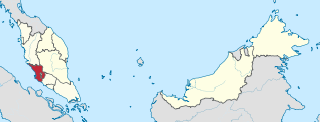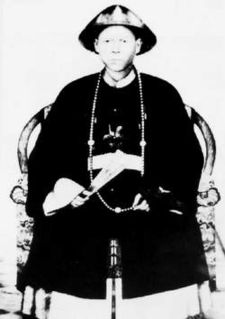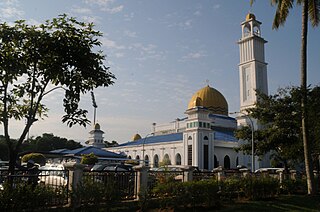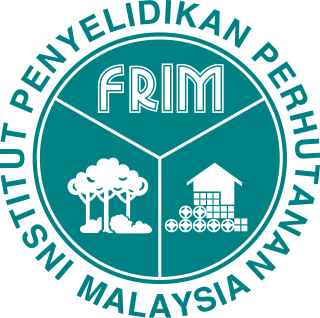
Selangor, also known by its Arabic honorific Darul Ehsan, or "Abode of Sincerity", is one of the 13 states of Malaysia. It is on the west coast of Peninsular Malaysia and is bordered by Perak to the north, Pahang to the east, Negeri Sembilan to the south and the Strait of Malacca to the west. Selangor surrounds the federal territories of Kuala Lumpur and Putrajaya, both of which were previously part of it.

Kapitan China Yap Ah Loy ; 14 March 1837 – 15 April 1885), also known as Yap Tet Loy and Yap Mao Lan, is an important figure of early Kuala Lumpur. He served as the third Kapitan China of Kuala Lumpur, and in this administrative capacity, played an important role in developing the city as a commercial and mining centre during the 19th century.

Kuala Kubu Bharu, is the district capital of Hulu Selangor District, Selangor, Malaysia. It was built after the town of Kuala Kubu was found to be unfit to continue as a town due to its severe flood problem, particularly when it was completely destroyed in a flood disaster in 1883. Kuala Kubu Bharu is located on the foothill of the famous Titiwangsa Mountain Range and well known as one of the vital water catchment area for the state of Selangor.

Rawang is a town and a mukim in Gombak District, Selangor, Malaysia, about 23 km northwest of city centre Kuala Lumpur.

The Gombak District is an administrative district located in the state of Selangor, Malaysia. The district was created on February 1, 1974, the same day when Kuala Lumpur was declared a Federal Territory. Until 1997, Rawang was the district capital; the capital has been moved to Bandar Baru Selayang. Gombak borders Kuala Lumpur to the southeast and the Genting Highlands to the east. Both Gombak and Kuala Lumpur, along with some other districts in Selangor, are situated within the Klang Valley. Other localities that are situated in Gombak district include Batu Arang, Kuang, Rawang, Bandar Kundang, Gombak Town, Selayang, Kepong and Hulu Kelang.
A mukim is a type of administrative division used in Brunei, Indonesia, Malaysia and Singapore. The word mukim is a loanword in English. However, it was also originally a loanword in Malay from the Arabic word: مقيم. The closest English translation for mukim is township.

The Forest Research Institute Malaysia is a statutory agency of the Government of Malaysia, under the Ministry of Land, Water and Natural Resources (KATS). FRIM promotes sustainable management and optimal use of forest resources in Malaysia by generating knowledge and technology through research, development and application in tropical forestry. FRIM is located in Kepong, near Kuala Lumpur.

Kuala Lumpur is the largest city in Malaysia; it is also the nation's capital. The history of Kuala Lumpur began in the middle of the 19th century with the rise of the tin mining industry, and boomed in the early 20th century with the development of rubber plantations in Selangor. It became the capital of Selangor, later the Federated Malay States, and then Malayan Union, and finally Malaya and Malaysia.

The Selangor State Park is a park located in Gombak District, Selangor, Malaysia. The 914.41 square kilometre park was gazetted on by the state on January 25, 2007. Upon its establishment, it became the second largest park in Peninsular Malaysia with the largest being the Taman Negara.
Temuan language is a Malayan language spoken by the Temuan people, one of the Orang Asli or indigenous peoples of Peninsular Malaysia which can be found in the states of Selangor, Pahang, Johor, Malacca and Negeri Sembilan. Temuan is a separate language but has a degree of mutual intelligibility with the Malay language. It is written in a Latin alphabet, but no standard orthography has been made.

The environment of Malaysia is the biotas and geologies that constitute the natural environment of Malaysia. Malaysia's ecology is megadiverse, with a biodiverse range of flora and fauna found in various ecoregions throughout the country. Tropical rainforests encompass between 59% to 70% of Malaysia's total land area, of which 11.6% is pristine. Malaysia has the world's fifth largest mangrove area, which totals over a half a million hectares.

Templer Park is a forest reserve in Rawang, Gombak District, Selangor, Malaysia. It is 1,214 hectares in size and it was named in honour of Sir Gerald Templer, a British High Commissioner in Malaya. "On 8 September 1954, His Highness the Sultan of Selangor, the late Sultan Hishamuddin Alam Shah declared that Templer’s Park was 'dedicated by Selangor to serve as a refuge and a sanctuary for wildlife and a meeting-place for all who love and respect the beauty of nature'. The following year the government gazetted the area as “a Botanical Garden and Public Park” under the land enactment ".

Kundang or Pengkalan Kundang refers to an area in Selangor, Malaysia. It is located approximately 17 km from Rawang, Selangor and 33 km north-west of Kuala Lumpur. Kundang is used to be agricultural village. But now, it is one of the modern villages in the state with its own highway, LATAR. It comes under the Gombak District, one of the biggest districts in the state of Selangor. Bandar Tasik Puteri, Pekan Kundang, Bandar Rawang is the nearest town from the village. Farming and related activities constitute the core economic drivers of this pastoral village. It comes under Selayang Parliament constituency, and falls into the jurisdiction of Majlis Perbandaran Selayang (MPS).
The Klang Gates Quartz Ridge is a quartz dyke that runs through northeast of Kuala Lumpur and the state of Selangor, Malaysia within Bukit Lagong-Kanching-Klang Gates region. With the dimension of more than 14 km long and 200 m wide, it is the longest quartz formation in the world. The other major quartz vein in Kuala Lumpur is along Kajang-Cheras road, which is about 8 km long, however the Klang Gates Quartz Ridge is one-of-its-kind because it has four types of quartz formation. The area has five endemic plants species among 265 species, found nowhere else in the world. A rare animal, the serow is found here as well.
Rawang Bypass, Federal Route 37 also known as Rawang–Serendah Highway, is a federally-funded divided highway bypass in Rawang, Selangor, Malaysia. The 10-km highway was opened to traffic on 28 November 2017 at 9.00 pm. Construction of the RM628mil Rawang Bypass began on 16 July 2005 and was completed on 21 November 2017. It features a 2.7-km elevated viaduct with its highest pillar of 58.2 meter. the highest of its kind in Malaysia.
Kerikam is a coarse metal thread made of gold or silver used for embroidering. The term kerikam comes from the French word clinquant. It is an important material in the Malay art of embroidery, traditionally used by the Malays in Brunei, Indonesia, Malaysia and southern Thailand. Kerikam embroidery can be found on baju kurung, kebaya and tudung.

Tawai Forest Reserve is a protected forest reserve in Telupid District of Sandakan Division, Sabah, Malaysia. It was first created in January 1972, before being designated as a Class 1 Protection Forest by the Sabah Forestry Department in 1984. It was fully demarcated in 2002, resulting in an area of 22,697 hectares (226.97 km2). The reserve is mostly mountainous, consisting of ultramafic forest, upland mixed dipterocarp forest and kerangas forest. Mount Tawai, at 1,273 metres (4,177 ft), is within the reserve. It is flattest near its northern and eastern edges. The Tawai waterfall is located within the reserve, part of the many rivers which flow through it. Protection of these headwaters was part of the reason for the reserve's establishment. The reserve has been badly affected by fires that have spread into the reserve from nearby settlements and palm oil plantations. Illegal logging has occurred in areas of dipterocarp forest. Illegal logging and land clearance has occurred in some portions of the reserve. There are plans for the Pan-Borneo Highway to be expanded in part through the northern portion of the reserve. The forestry department runs a Rainforest Camp to generate tourism money, providing access to the clean river water of the reserve, rainforest treks, and a waystop near the path of the Sandakan Death Marches.

Ulu Telupid Forest Reserve is a protected forest reserve in Tongod District of Sandakan Division, Sabah, Malaysia. First established in 1972, it was designated as a Class 1 Protection Forest by the Sabah Forestry Department in 1984. Its area is 6,460 hectares (64.6 km2), down from its former size of 7,508 hectares (75.08 km2). Prior to being established as a forest reserve, the area was used for logging and palm oil plantations. The reserve is mostly mountainous, consisting mainly of mixed dipterocarp forest. The land surrounding the reserve includes a town, oil palm plantations, rubber plantations, and rice paddies. It is threatened by fires and illegal logging. In some areas agricultural activities have encroached into the protected area. Since 2000 there has been a net loss of just under 2% of the reserve's forested area. There is a small level of ecotourism activity in the reserve, consisting of guided tours from a nearby village, which provides livelihood alternatives to logging and poaching.

Botitian Forest Reserve is a protected forest reserve in Beluran District of Sandakan Division, Sabah, Malaysia. It was designated as a Class 1 Protection Forest by the Sabah Forestry Department in 1992. Its area is 2,145 hectares (21.45 km2). Botitian's terrain is mountainous in the reserve's centre, to low hills and flat land in the western and eastern sections. The forest is mainly secondary with pioneer species. Canopy trees are mainly dipterocarp.
Hopea treubii is a tree in the family Dipterocarpaceae, native to Borneo. It is named for the Dutch botanist Melchior Treub.












